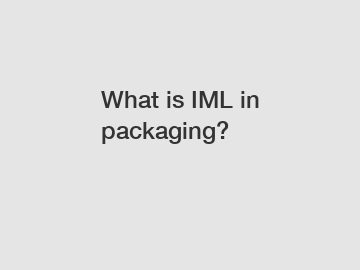Jan. 10, 2024
Packaging & Printing
If you want to learn more, please visit our website HONOKAGE.
What is IML in packaging? .
IML stands for In-Mold Labeling, which is a process of applying labels to packaging containers during the injection molding process. In this process, the label is placed inside the mold before the molten plastic is injected, allowing it to bond seamlessly with the container surface. As the plastic cools and solidifies, the label becomes an integral part of the package, resulting in a high-quality, durable, and visually appealing print.

The concept of in-mold labeling originated in the 1970s and gained popularity in the packaging industry due to its numerous advantages over traditional labeling methods. The conventional methods of labeling, such as pressure-sensitive or heat transfer labels, require a separate labeling process, which adds complexity, time, and cost to the packaging production. In-Mold Labeling, on the other hand, eliminates the need for an additional labeling step as the label is directly molded into the package, saving time and minimizing production line complexity.
The process of IML involves several steps. It begins with the design and printing of the labels, which are usually made of a thin, flexible material like polypropylene. The labels can be printed using various techniques, including flexographic or gravure printing, allowing for intricate designs, vibrant colors, and high-resolution graphics. Once the labels are ready, they are precisely positioned inside the mold using special robotic systems. During the injection molding process, the molten plastic is injected into the mold, surrounding the label and creating a strong bond. After cooling, the mold opens, and the finished product, with the label securely embedded, is ejected.
The significance of in-mold labeling in packaging lies in its ability to enhance the product's aesthetics, durability, and branding. The seamless integration of the label with the package prevents it from peeling, fading, or scratching, even in demanding conditions. This makes IML suitable for various industries, including food and beverage, personal care, and household products, where packaging needs to withstand moisture, heat, or frequent handling. Additionally, the high-quality printing offered by IML allows for the reproduction of detailed and intricate designs, helping brands to create visually appealing and eye-catching packaging.
Furthermore, the use of IML contributes to sustainability and waste reduction efforts. As the label is an integral part of the package, it eliminates the need for additional adhesive layers or labeling materials that often end up as waste. Moreover, the durability of in-mold labels ensures that the packaging remains intact throughout its lifecycle, reducing the likelihood of product damage, and thereby minimizing potential waste.
In conclusion, In-Mold Labeling (IML) is a process of applying labels to packaging containers during the injection molding process. It offers advantages like seamless integration, high-quality printing, durability, and sustainability. IML has revolutionized the packaging industry by providing a cost-effective and efficient labeling solution that enhances product appeal and reduces waste.
For more information, please visit our website.
For more IML packaging factoryinformation, please contact us. We will provide professional answers.
If you are interested in sending in a Guest Blogger Submission,welcome to write for us!
All Comments ( 0 )